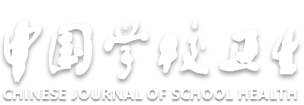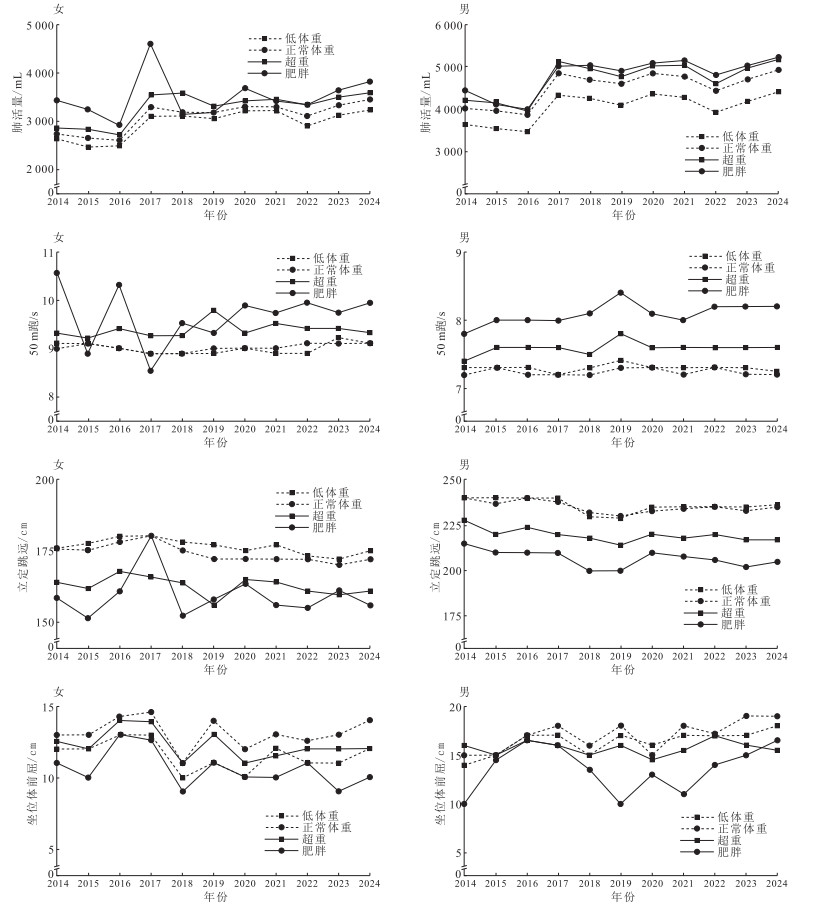Analysis of physical fitness test results for freshmen with different nutritional status at Civil Aviation University of China from 2014 to 2024
-
摘要:
目的 分析2014—2024年中国民航大学不同体质量指数(BMI)分组大一新生体质测试(简称“体测”)测数据状况及趋势,为高校学生体质健康监测和干预提供科学依据。 方法 对中国民航大学2014—2024年全体67 949名大一新生进行普查,体测项目包括肺活量、坐位体前屈、仰卧起坐、50 m跑、立定跳远、引体向上、800/1 000 m跑等。采用世界卫生组织标准将大一新生依据BMI分为低体重、正常体重、超重和肥胖组,使用Kruskal-Wallis H检验比较不同性别和BMI分组间各体能指标的差异,使用Mann-Kendall趋势检验检测时间序列中各体能指标的上升或下降趋势。 结果 2014—2024年,男、女生肺活量、50 m跑、立定跳远和坐位体前屈在不同BMI分组之间差异均有统计学意义(男生:Z值分别为2 396.40,4 160.33,4 662.23,531.85;女生:Z值分别为593.37,308.86,499.37,128.70),男生1 000 m跑和引体向上、女生800 m跑和仰卧起坐在不同BMI分组之间差异均有统计学意义(男生:Z值分别为6 574.80,6 880.48;女生:Z值分别为528.56,146.18)(P值均 < 0.01)。2014—2024年,大一新生总体体测成绩呈现下降趋势,超重和肥胖组更明显。2014年男生肺活量高于全国体质调研数据(差值为320 mL)、到2019年差距扩大至734 mL,女生肺活量与全国体质调研数据的差值从2014年的271 mL增长到2019年的576 mL;男生1 000 m跑较2014年和2019年全国体质调研数据分别快23.0和17.5 s,女生800 m跑较2014年和2019年全国体质调研数据分别快22.3和21.5 s。 结论 该校大一新生体质健康状况在不同BMI分组间存在差异且随时间变化。虽然整体体测成绩高于全国水平,但仍需关注体测成绩下降的趋势。 Abstract:Objective To analyze the status and trends of physical fitness test data among college freshmen with different body mass index (BMI) groups from 2014 to 2024, providing the scientific evidence for monitoring and intervening in college students' physical health. Methods A census was conducted on all 67 949 freshmen at Civil Aviation University of China from 2014 to 2024. Physical tests included vital capacity, sit-and-reach, sit-ups, 50 m sprint, standing long jump, pull-ups, and 800 m/1 000 m run. Freshmen were divided into underweight, normal weight, overweight and obese groups according to WHO BMI standards. The Kruskal-Wallis H test was used to compare differences in physical fitness indicators across gender and BMI groups, while the Mann-Kendall trend test was employed to detect upward or downward trends in physical indicators over time. Results From 2014 to 2024, statistically significant differences were observed in vital capacity, 50 m sprint, standing long jump, and sit-and-reach among different BMI groups for both genders (boy: Z=2 396.40, 4 160.33, 4 662.23, 531.85; girl: Z=593.37, 308.86, 499.37, 128.70). Significant differences were also found in 1 000 m run and pull-ups for boys, and 800 m run and sit-ups for girls across BMI groups (boy: Z=6 574.80, 6 880.48; girl: Z=528.56, 146.18) (P < 0.01). Overall physical test scores showed a declining trend during 2014-2024, particularly pronounced in overweight and obese groups. Male vital capacity in 2014 exceeded national survey data(d=320 mL), with the gap widening to 734 mL by 2019, while the female vital capacity difference increased from 271 mL in 2014 to 576 mL in 2019. Male 1 000 m run times were 23.0 s and 17.5 s faster than national data in 2014 and 2019 respectively, while female 800 m run times were 22.3 s and 21.5 s faster than corresponding national data. Conclusions Physical health status among freshmen at this university varies across BMI groups and changes over time. Although overall test scores remain higher than national levels, the declining trend in physical fitness performance requires attention. -
Key words:
- Nutritional status /
- Body constitution /
- Health status /
- Students
1) 利益冲突声明 所有作者声明无利益冲突。 -
表 1 大一新生2014和2019年体测结果与全国学生体质调研数据比较[M(P25, P75)]
Table 1. Comparison of physical fitness results among freshmen in college and the national students' physical fitness survey data between 2014 and 2019[M(P25, P75)]
性别 体测项目 2014年 2019年 体测结果 全国体质调研 体测结果 全国体质调研 男 肺活量/mL 4 000.0(2 000.0, 7 500.0) 3 680.0(3 185.0, 4 245.0) 4 570.0(1 470.0, 9 300.0) 3 836.0(3 329.0, 4 413.0) (n=47 289) 50 m跑/s 7.3(5.9, 13.0) 7.5(7.1, 8.0) 7.4(5.8, 11.2) 7.5(7.1, 8.0) 立定跳远/cm 237.0(140.0, 338.0) 225.0(210.0, 240.0) 227.0(140.0, 290.0) 221.0(205.0, 238.0) 坐位体前屈/cm 13.0(0, 30.0) 11.0(5.9, 15.8) 14.0(-15.0, 31.0) 10.8(5.4, 15.9) 引体向上/个 4.0(0, 30.0) 3.0(1.0, 6.0) 4.0(0, 39.0) 3.0(1.0, 6.0) 1 000 m跑/s 237.0(181.0, 481.0) 260.0(239.5, 284.5) 241.0(181.0, 421.0) 258.5(237.1, 285.5) 女 肺活量/mL 2 690.0(1 100.0, 7 800.0) 2 419.0(2 054.0, 2 814.0) 3 150.0(1 210.0, 6 000.0) 2 574.0(2 205.0, 2 996.0) (n=20 660) 50 m跑/s 9.2(6.6, 13.1) 9.5(8.9, 10.2) 9.1(6.2, 13.4) 9.5(8.9, 10.1) 立定跳远/cm 175.0(108.0, 245.0) 166.0(154.0, 180.0) 174.0(120.0, 230.0) 163.0(150.0, 177.0) 坐位体前屈/cm 15.0(0, 30.0) 13.7(9.1, 18.1) 17.0(-10.0, 33.0) 14.5(9.6, 19.3) 仰卧起坐/个 33.0(0, 62.0) 31.0(25.0, 38.0) 36.0(10.0, 64.0) 32.0(26.0, 40.0) 800 m跑/s 235.0(181.0, 348.0) 257.3(239.7, 280.3) 234.0(181.0, 356.0) 255.5(237.2, 278.3) 注:全国体质调研数据为17~18岁年龄段学生数据。 表 2 不同BMI分组男、女生各体测指标比较[M(P25,P75)]
Table 2. Comparison of various physical fitness indicators among boys and girls under different BMI groups[M(P25, P75)]
组别 人数 男生 肺活量/mL 50 m跑/s 立定跳远/cm 坐位体前屈/cm 引体向上/个 1 000 m跑/s 低体重 5 430 4 013.5(3 498.5,4 562.8) 7.3(7.0,7.6) 235.0(222.0,249.0) 11.5(7.0,16.0) 6.0(3.0,10.0) 235.0(221.3,247.0) 正常体重 33 523 4 501.0(3 950.0,5 130.0) 7.3(6.9,7.6) 235.0(220.0,249.0) 13.0(9.0,17.0) 4.0(2.0,19.0) 234.0(219.0,247.0) 超重 6 743 4 761.0(4 161.5,5 386.0) 7.6(7.3,8.0) 220.0(208.0,233.0) 12.0(8.0,16.0) 1.0(0,3.0) 253.0(241.0,271.0) 肥胖 1 593 4 852.0(4 215.0,5 450.0) 8.1(7.6,8.5) 208.0(190.0,220.0) 10.0(6.0,15.0) 0(0,1.0) 283.0(259.0,308.0) Z值 2 396.40 4 160.33 4 662.23 531.85 6 880.48 6 574.80 P值 <0.01 <0.01 <0.01 <0.01 <0.01 <0.01 组别 人数 女生 肺活量/mL 50 m跑/s 立定跳远/cm 坐位体前屈/cm 仰卧起坐/个 800 m跑/s 低体重 6 140 2 924.0(2 507.0,3 369.0) 9.1(8.6,9.6) 177.0(165.0,188.0) 16.0(12.0,20.0) 36.0(31.0,42.0) 235.0(221.0,247.0) 正常体重 13 574 3 131.0(2 680.0,3 578.0) 9.1(8.7,9.6) 174.0(162.0,185.0) 17.0(13.0,21.0) 37.0(31.0,42.0) 235.0(222.0,248.0) 超重 810 3 377.0(2 908.5,3 801.5) 9.5(9.0,10.0) 163.0(152.0,175.0) 16.0(12.0,19.0) 34.0(29.0,40.0) 248.0(237.0,265.0) 肥胖 136 3 500.0(3 066.0,3 889.3) 9.9(9.4,10.4) 156.5(145.8,170.0) 15.0(10.0,18.0) 30.0(26.8,37.0) 271.5(248.0,299.3) Z值 593.37 308.86 499.37 128.70 146.18 528.56 P值 <0.01 <0.01 <0.01 <0.01 <0.01 <0.01 -
[1] KOLBE L J. School health as a strategy to improve both public health and education[J]. Annu Rev Public Health, 2019, 40: 443-463. doi: 10.1146/annurev-publhealth-040218-043727 [2] LYU Z, HOU Y, WANG Y. Research on the current situation of college students' physical health under the background of the integration of sports and medicine[J]. J Healthc Eng, 2022, 2022: 1581282. http://www.socolar.com/Article/Index?aid=100093963236&jid=100000012057 [3] WANG J. The association between physical fitness and physical activity among Chinese college students[J]. J Am Coll Health, 2019, 67(6): 602-609. doi: 10.1080/07448481.2018.1515747 [4] YUMEI J, CHEN D, BO S, et al. The relationship between physical fitness and BMI among Chinese university students: results of a Longitudinal study[C]//Organizing Committee of the 2nd International Conference on Computers, Information Processing and Advanced Education. Proceedings of the 2nd International Conference on Computers, Information Processing and Advanced Education. Ottawa, Canada: ACM Digital Library, 2021: 213-217. [5] JIANG S, PENG S, YANG T, et al. Overweight and obesity among Chinese college students: an exploration of gender as related to external environmental influences[J]. Am J Mens Health, 2018, 12(4): 926-934. doi: 10.1177/1557988317750990 [6] MIN Z. The shifting burden of obesity: changes in the distribution of obesity in China, 2010-2015[J]. Int Sociol, 2019, 34(3): 347-367. doi: 10.1177/0268580919832734 [7] LONATI E, CAZZANIGA E, ADORNI R, et al. Health-related lifestyles among university students: focusing on eating habits and physical activity[J]. Int J Environ Res Public Health, 2024, 21(5): 626. doi: 10.3390/ijerph21050626 [8] WILKS C R, AUERBACH R P, ALONSO J, et al. The importance of physical and mental health in explaining health-related academic role impairment among college students[J]. J Psychiatr Res, 2020, 123: 54-61. doi: 10.1016/j.jpsychires.2020.01.009 [9] DONG X, HUANG F, STARRATT G, et al. Trend in health-related physical fitness for Chinese male first-year college students: 2013-2019[J]. Front Public Health, 2023, 11: 984511. doi: 10.3389/fpubh.2023.984511 [10] JOURDAN D, GRAY N J, BARRY M M, et al. Supporting every school to become a foundation for healthy lives[J]. Lancet Child Adolesc Health, 2021, 5(4): 295-303. doi: 10.1016/S2352-4642(20)30316-3 [11] World Health Organization. Obesity: preventing and managing the global epidemic. Report of a WHO consultation[J]. World Health Organ Tech Rep Ser, 2000, 894: 16. http://www.cabdirect.org/abstracts/20013033798.html [12] 雒满, 王海, 陈志超. 《国家学生体质健康标准》发展历程研究[J]. 体育科技, 2017, 38(1): 94-95.LUO M, WANG H, CHEN Z C. Research on the development history of National Student Physical Health Standard[J]. Sports Sci Technol, 2017, 38(1): 94-95. (in Chinese) [13] 中国学生体质与健康研究组. 2014年中国学生体质与健康调研报告[M]. 北京: 高等教育出版社, 2016.Research Group on Chinese Students' Physical Fitness and Health. Report on the survey of physical fitness and health of Chinese students in 2014[M]. Beijing: Higher Education Press, 2016. (in Chinese) [14] 中国学生体质与健康研究组. 2019年中国学生体质与健康调研报告[M]. 北京: 高等教育出版社, 2021.Research Group on Chinese Students' Physical Fitness and Health. Report on the survey of physical fitness and health of Chinese students in 2019[M]. Beijing: Higher Education Press, 2021. (in Chinese) [15] PATAKY M W, DASARI S, MICHIE K L, et al. Impact of biological sex and sex hormones on molecular signatures of skeletal muscle at rest and in response to distinct exercise training modes[J]. Cell Metab, 2023, 35(11): 1996-2010. doi: 10.1016/j.cmet.2023.10.010 [16] HOOG S, ANDERSSON E P. Sex and age-group differences in strength, jump, speed, flexibility, and endurance performances of swedish elite gymnasts competing in teamgym[J]. Front Sports Act Living, 2021(3): 653503. [17] WONGPRAWMAS R, SOGARI G, MENOZZI D, et al. Strategies to promote healthy eating among university students: a qualitative study using the nominal group technique[J]. Front Nutr, 2022(9): 821016. [18] JAVIER A, RAFAEL Z, DANIEL R, et al. Overweight/obese schoolchildren with low muscle strength have a lower cardiorespiratory capacity and greater cardiovascular risk: results of the school health survey of the extreme south of chile 2019[J]. Children(Basel), 2021, 8(9): 734. http://pubmed.ncbi.nlm.nih.gov/34572166/ [19] CHEN D, YUMEI J. The relationship between body mass index and physical fitness among Chinese university students: results of a longitudinal study[J]. Healthcare, 2020, 8(4): 570. doi: 10.3390/healthcare8040570 [20] MUSÁLEK M, CLARK C C T, KOKŠTEJN J, et al. Impaired cardiorespiratory fitness and muscle strength in children with normal-weight obesity[J]. Int J Environ Res Public Health, 2020, 17(24): 9198. doi: 10.3390/ijerph17249198 [21] PETROVICS P, SANDOR B, PALFI A, et al. Association between obesity and overweight and cardiorespiratory and muscle performance in adolescents[J]. Int J Environ Res Public Health, 2020, 18(1): 134. doi: 10.3390/ijerph18010134 [22] XU Y, MEI M, WANG H, et al. Association between weight status and physical fitness in Chinese mainland children and adolescents: a cross-sectional study[J]. Int J Environ Res Public Health, 2020, 17(7): 2468. doi: 10.3390/ijerph17072468 [23] PUENTE-HIDALGO S, PRADA-GARCÍA C, BENÍTEZ-ANDR-ADES J A, et al. Promotion of healthy habits in university students: literature review[J]. Healthcare, 2024, 12(10): 993. doi: 10.3390/healthcare12100993 [24] DENG Y, HWANG Y, CAMPBELL S, et al. Institutional factors associated with college students' healthy physical activity and body composition: a first semester follow-up[J]. J Am Coll Health, 2021, 71(4): 1134-1142. http://pubmed.ncbi.nlm.nih.gov/34260332/ [25] HAYES J F, BALANTEKIN K N, GRAHAM A K, et al. Implementation intentions for weight loss in college students with overweight and obesity: a proof-of-concept randomized controlled trial[J]. Transl Behav Med, 2020, 11(2): 359-368. [26] ZHOU H, HAZEL D. The effect of aerobic exercise among obese college students: towards an intervention program[J]. Int J Educ Hum, 2024, 14(2): 198-203. [27] PFISTERER J, RAUSCH C, WOHLFARTH D, et al. Effectiveness of physical-activity-based interventions targeting overweight and obesity among university students: a systematic review[J]. Int J Environ Res Public Health, 2022, 19(15): 9427. doi: 10.3390/ijerph19159427 [28] DOST A, ESIN M N. Effects of the UNI-PAHNP on physical activity and nutrition behaviors in overweight/obese university students in Turkey[J]. Perspect Psychiatr Care, 2022, 58(4): 2003-2016. doi: 10.1111/ppc.13022 [29] NHO J, CHAE S. Effects of a lifestyle intervention on health-promoting behavior, psychological distress and reproductive health of overweight and obese female college students[J]. Healthcare, 2021, 9(3): 309. doi: 10.3390/healthcare9030309 [30] BIHUNIAK J D, BRYANT T, KLEIMAN J, et al. Behavioural weight loss treatment preferences of college students with overweight and obesity[J]. Clin Obes, 2019, 10(1): e12343. doi: 10.1111/cob.12343/abstract -







 下载:
下载:


